How Many Solar Panels Do I Need? (Solved)
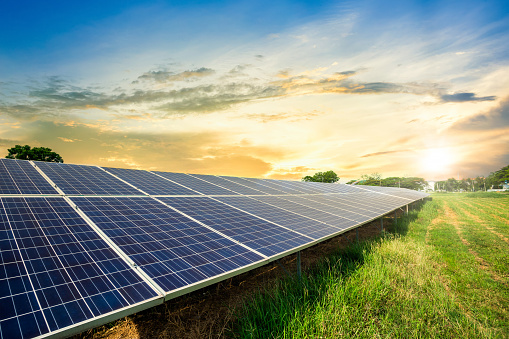
Are you thinking about going solar? It’s a great feeling, knowing that you’re helping the planet and saving money at the same time. Now, the next question is: How many solar panels do you need for your home?
The answer depends on a few factors:
- Your specific energy demand
- The amount of sunlight exposure your home receives
- The power output of your panels
In this blog post, we’ll provide an overview of how solar panel sizing works, as well as some tips for calculating the correct number of solar panels for your home.
How many solar panels do I need?
On average, a home in the U.S. needs 18-24 solar panels to go completely off-grid. However, that number can vary depending on the size of your home, how much sunlight you receive, and your electricity usage.
If you’re interested in installing solar panels, it’s best to consult with a professional to help you determine exactly how many you’ll need. They can take all of the unique factors affecting your home and give you the most accurate estimate.
Total electricity consumption (kWh)
The number of solar panels you need for your home depends on a few factors, the most important of which is your monthly electricity consumption.
Determining your home’s total electricity consumption is not as difficult as it may seem.
Look at past electricity bills and find the total kilowatt hours (kWh) used over a year (annual energy usage). Then divide total kilowatt-hours by 12 to find your home’s average monthly electricity usage.
Knowing your home’s average energy usage is essential when calculating the number of solar panels you need. That number will tell you how large of a solar energy system you’ll need to generate the amount of electricity you use each month.
Remember that you’ll also need to account for shading and other factors that may affect your system’s performance.
To get a more accurate estimate, it’s always best to have a solar installer come out and do a site survey. But using this simple calculation will give you a general idea of what you need.
Find out how much sunlight you receive in your area (peak sun hours)
Peak sun hours are the number of hours during the day when your location receives the most direct sunlight. Knowing this information is essential when calculating how many solar panels you need for your home.
Your residential solar panels will produce the most energy during the times of day when the sun is shining directly on them. That’s because the sun doesn’t shine with the same intensity at all times of the day. For example, morning sunlight is not as strong as the sunlight at noon.
Institutions such as NREL provide solar resource and sunlight data by states and cities.
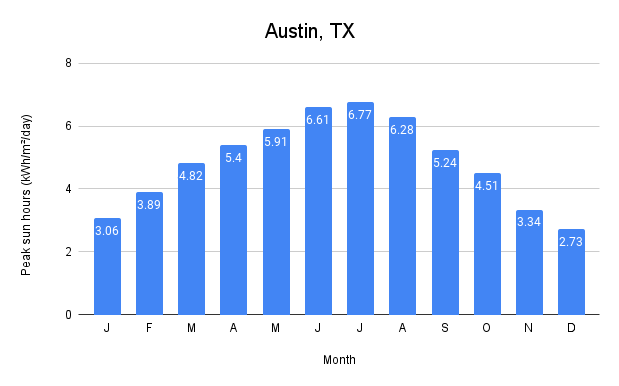
Source: Pveducation.org
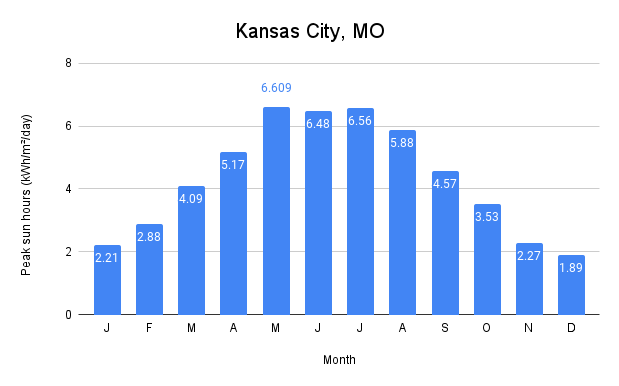
Source: Pveducation.org
To determine how many kWh your solar panels produce in a day, multiply the number of watts your solar panel makes by the number of peak sunlight hours.
For example, if you have a solar panel that produces 250 watts and your location has four direct sun hours, your solar panel will produce 1,000 kWh in a day.
Output Power Rating (solar panel wattage)
A solar panel’s power rating measures its power in watts.
You can typically expect a solar panel to generate anywhere from 250 watts to 450 watts of power.
340 watts is a standard panel wattage on the market.
However, the solar panel wattage can vary depending on the type of solar panel and other installation factors.
The output power rating is critical when calculating how many solar panels you need for your home or business.
How to calculate how many solar panels you need
Let’s use an example to help illustrate how to calculate the number of solar panels you need.
Total energy consumption
Remember to find your energy consumption by looking at your past monthly utility bills.
Say your home’s average monthly electricity usage is 1,500 kWh, and you live in California.
To go completely off-grid, you need a solar energy system that produces at least 1,500 kWh per month.
Peak sunlight hours
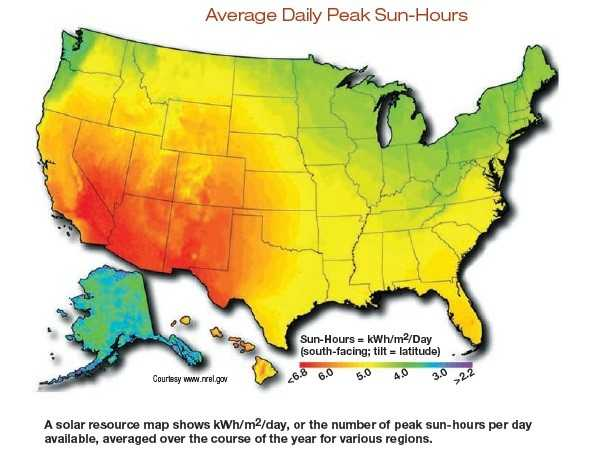
Peak sunlight hours vary depending on where you live. The closer to the equator, the more hours of peak sunlight you will have. For our example, let’s use the average peak sunlight hours from Los Angeles, California:
5.62 Daily Peak Sunlight hours
To calculate monthly, you will multiply daily peak sunlight hours by 30.
(5.62 daily direct sun hours x 30 days) = 168.6 monthly peak sun hours
Plug Consumption and Peak Sun Hours Into the Formula
Once you know your maximum sunlight hours, you can calculate the number of solar panels you need by dividing your total energy consumption (measured in kWh) by the direct sun hours.
For example, if you have a monthly electricity consumption of 1,500 kWh, you would divide that by 168.6 sun hours to get 8.9 kW.
In other words, your solar array (system size) needs to be 8.9 kW to meet your monthly energy consumption.
For the sake of simplicity, we will round up to 9 kW.
Convert kW to Watts
Simply multiply your kW by 1000.
9 kW would be 9000 Watts.
Solar Panels Power
The power of most panels ranges from 250 to 350 watts.
For our example, we will decide to invest in 340-watt solar panels.
9000 Watts / 340 Watts solar panels = 26.5 panels
So, if you have a 9 kW system, you would need anywhere from 27 to 28 solar panels to meet your energy needs.
It is important to note that if your energy demand varies month-to-month, you may want a solar power system with a little more wattage to ensure you always have enough energy.
How Many Do I Need For My Roof Design?

Designing a roof is not just about aesthetics – it’s also about maximizing the amount of solar energy your solar power system can capture. Specifically, your roof design has a lot to do with the number of solar panels you need and what kind you should buy.
A well-angled and spacious roof will allow for more panels, but if you don’t have a lot of area on your roof, you might need to buy more efficient or costlier solar panels.
A tilt of 25% is the optimal pitch for most solar panels, but anything between 15-30 degrees will work.
The direction your roof faces also impacts how much solar power can be generated – a south-facing roof will generate more power than a north-facing one.
If your roof doesn’t face south, you might not get as much solar generation as you would if it did. However, east- and west-facing roofs can still be effective for solar energy production.
If you’re thinking about solar panels, it’s essential to consider your roof design and how it will affect the overall cost and efficiency of the system. Talk to a solar installer to get more specific advice for your home.
How Many Do I Need For Common Appliances?
Appliances in your home significantly affect energy consumption. The energy usage of air conditioners, refrigerators, washers, and dryers can greatly impact how much energy your solar system needs to produce.
By knowing how much different power appliances use, you can make more informed decisions about what to include in your solar array. High energy usage appliances can offset the savings you would get from other smaller devices running off solar power.
That’s why it’s helpful to track energy usage for individual appliances. By knowing how much energy each appliance uses, you can make changes that will save you money on your electricity bill. You can also use this information to help you choose more efficient appliances when it’s time to replace them.
Tracking energy usage is easy. The easiest way is to track your usage daily or monthly. Most utility companies even break it down by day and hour, so you can see how your appliance usage changes throughout the day. You can also find the wattage of your appliances on their energy labels. This information will help you size your solar panel system and save money on your utility bills.
How Many Do I Need In My Solar Panel System If I Have a Lot of Trees?
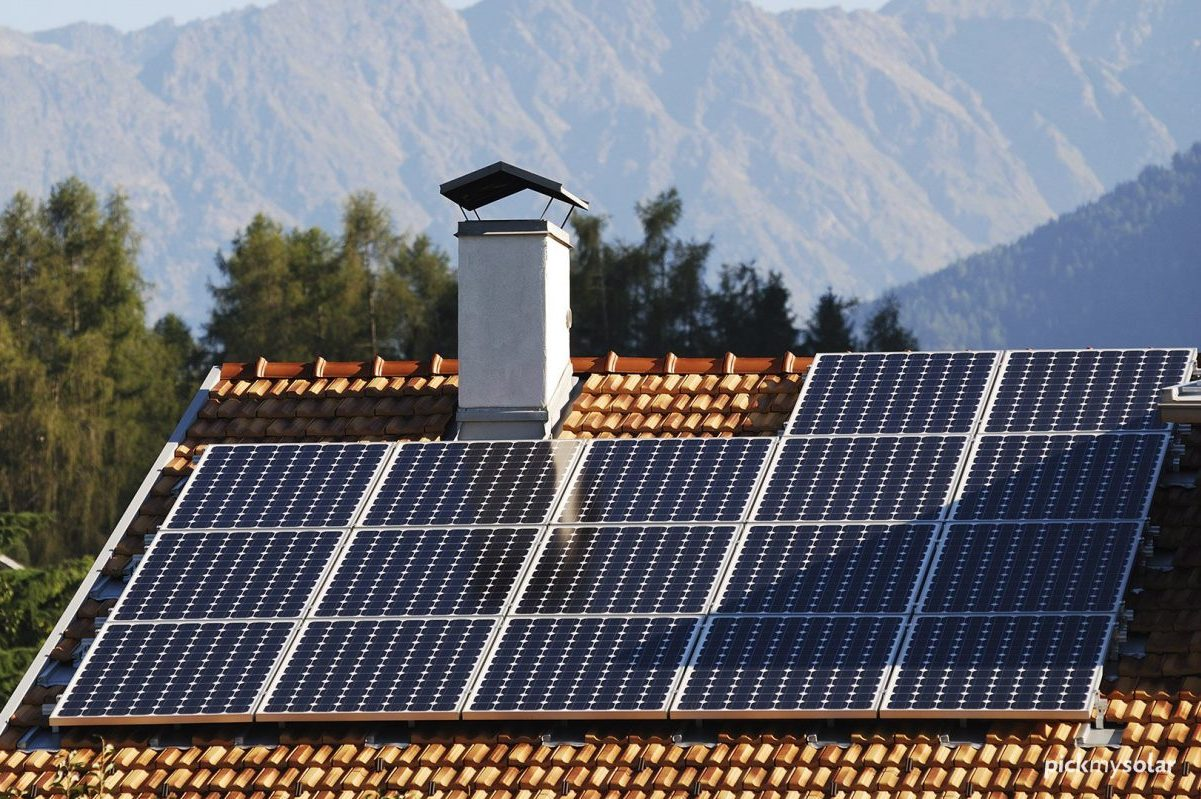
Shade or trees can greatly impact the number of solar panels you need. If you have a lot of trees, your solar panel output efficiency decreases.
Even if your location has high direct sun hours, this is an important consideration. Since peak sun hours only tell you how much power the sun is providing at any given time, it doesn’t consider how much shade or clouds are blocking the sun.
That’s why it’s essential to consider your location and the surrounding trees when sizing a solar system. For example, if you have a lot of trees, you may need a larger solar panel system to produce the same amount of energy. Or, you may need to invest in high-efficiency solar panels.
Future Energy Plans: How Many Solar Panels Will I Need?
When homeowners are considering using solar systems, one of the most important things to think about is how much energy they will need in the future. Some factors to consider when planning for your future solar power system include the number of people living in your home, how many devices you use, and your daily energy consumption habits.
It’s important to remember that the amount of solar energy you need may change over time, so planning ahead is essential. Installing a more extensive solar system than you end up needing can be costly, so it’s best to overestimate rather than underestimate.
How Much Roof Space Do You Need for a Home Solar System?
The amount of roof space you need for your solar panels depends on the system size and your overall energy needs.
To determine how much roof area your solar system will require, multiply the volume of panels you’ll need by 17.55 square feet since that’s the typical size a panel uses.
For an average American home, you would need about 25 panels. This would cover 478 square feet of roof space.
How Many Solar Panels Are Required to Power a Home Entirely Off The Grid?
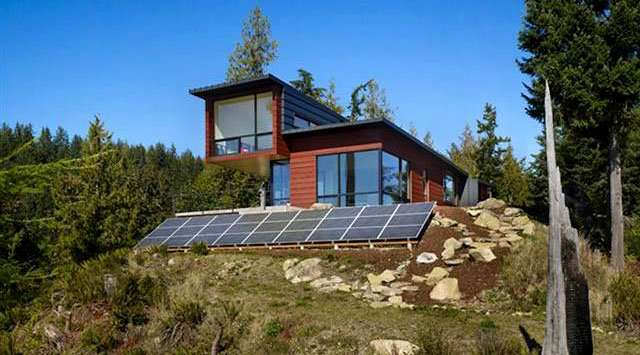
The numbers can vary when it comes to the number of solar panels it takes to power a typical American home. Factors to consider are:
- The appliances inside
- The power of your solar panels
- How much sun exposure your home receives
What Are a Typical Family’s Energy Needs?
The typical American family lives in a 2,000 sq. feet home and needs around 11,000 kilowatt-hours of electricity a year.
In order to calculate the number of solar panels you need to power your home, you’ll need to know the total monthly energy consumption, the direct sunlight hours, and wattage of your solar panels. Putting these variables together will give you an idea of the total system size.
In this case, the monthly energy needs are:
11,000 kilowatt-hours (year) / 12 months = 916 kWh per month
Next, you will find the monthly peak sun hours.
8 peak sun hours per day x 30 days = 240 peak sun hours per month
Next, divide your total system energy needs by monthly peak sun hours:
916 kWh / 240 peak sun hours = Solar system size of 3.82 kW or 3820 watts
To determine how many panels you need, take your total system size and divide that by expected power output:
3820 watts / 340 watts = 11.2 panels
So the total number of solar panels you would need is between 11 and 12 solar panels to make your home entirely off the grid.
Keep in mind that this is just a general estimate and your home may require more or fewer panels, depending on your specific needs. For example, if you have a lot of appliances that run on electricity, or if you live in a sun-abundant area, you may need more or less solar panels to power your home.
What’s The Average Cost of Solar Panels?
Solar panels cost anywhere from $1 per watt to $1.5 per watt.
There are three types of solar panels: monocrystalline, polycrystalline, and Thin-Film Solar Panels.
Monocrystalline Solar Panels
Monocrystalline solar panels are the most energy-efficient option, but they also have the highest price tag (between $.85 to $1.50 per watt).
They’re made of a single, large crystal of silicon, which gives them high efficiency.
For an 8 kW solar panel system, you can expect to pay around $8,000 – $12,000 for monocrystalline panels.
Polycrystalline Solar Panels
Polycrystalline solar panels are less efficient but also less expensive (around $0.85 to $1.05 per watt).
For an 8kW polycrystalline solar panel system, your cost will be around $6,800 – $8,400.
Thin-Film Solar Panels
Thin-Film Solar Panels are around $1 to $1.50 per watt, but they’re also very bulky and less practical than the other two types of solar panels. Hence, they’re used primarily in commercial projects. For an 8 kW thin-film solar panel system, you can expect to pay around $8,000 – $12,000.
In terms of the cost-benefit equation, solar panels represent a great investment. However, the average cost of solar panels is dropping all the time as technology improves and demand grows, so it’s worth checking out what’s available in your area. In addition, with federal tax credits and state incentives, you may be able to offset.
How Much Do Solar Panels Save?
According to the USEIA, owning solar can save you upwards of 90% of your electricity per month. Since the average American spends around $115 per month on electricity, they can save over $1242 worth of savings per year!
How much solar panels save you depends upon a few factors. The amount of sunlight you receive, the angle of your roof, and the type of solar panels all play a role in how much you save. But, most importantly, the amount of money you save will depend upon your current expenditure on electricity.
That’s not to mention the tax deductions and rebates you can receive if you decide to install solar panels. In many cases, the cost of solar panels can be offset by these incentives.
Overall, solar panels are a great way to save money on your energy bill. They provide long-term savings and help reduce your carbon footprint on fossil fuels. If you’re interested in saving money and going green, be sure to consult with a professional.

